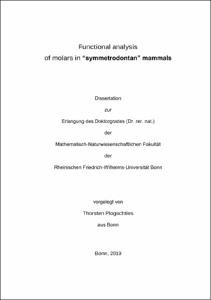Functional analysis of molars in “symmetrodontan” mammals

Functional analysis of molars in “symmetrodontan” mammals

| dc.contributor.advisor | Martin, Thomas | |
| dc.contributor.author | Plogschties, Thorsten | |
| dc.date.accessioned | 2020-04-27T15:45:24Z | |
| dc.date.available | 2020-04-27T15:45:24Z | |
| dc.date.issued | 10.03.2020 | |
| dc.identifier.uri | https://hdl.handle.net/20.500.11811/8297 | |
| dc.description.abstract | The “symmetrodontan” molar pattern is characterized by triangulation of the main cusps in combination with a reversed-triangle occlusion. In the fossil record, the “symmetrodontan” molar pattern occurred in various taxa of Mesozoic mammals with an insectivorous diet. These taxa were traditionally summarized in the paraphyletic group “Symmetrodonta”. In molar evolution, the “symmetrodontan” molar pattern is nested in-between the cusp in line type of “triconodontans” and the pretribosphenic molars of Cladotheria. Within the evolution of the „symmetrodontans“, their molar morphology evolved towards a more acute triangulation of the three main cusps and sharp shearing crests. On the base of this triangulation, the "symmetrodontans" can be differentiated into three groups. The early diverging Woutersiidae, Tinodontidae, and Kuehneotheriidae encompass the obtuse angled “symmetrodontans”. Spalacotheriidae comprises the acute-angled “symmetrodontans”, and Zhangheotheriidae, formerly included into the acute-angled “symmetrodontans”, are herein classified as an intermediate-angled taxon. The functional molar occlusion analysis of representatives of each class revealed that all “symmetrodontans” performed a one-phased transverse upward movement of the lower jaw, with a slight mesial or distal shift. Another feature that all “symmetrodontans” had in common, was the embrasure shearing. All studied “symmetrodontans”, except for Kuehneotheriidae, performed an embrasure shearing, in which two upper molars embraced one lower molar. The embrasure shearing of kuehneotheriids, in contrast, was proceeded within the cusp level. Despite the similarity of the mandible movement, the respective groups have a unique mode of functional occlusion. Generally, Woutersia butleri (Woutersiidae) comminuted food by puncture-crushing, Kuehneotherium praecursoris (Kuehneotheriidae) by puncture-shearing, Maotherium sinense (Zhangheotheriidae) by blunt-shearing, and Spalacolestes cretulablatta (Spalacotheriidae) by shear-cutting. Additionally, as a result of their higher width/length-ratio, the acute-angled “symmetrodontans” inflicted more damage to the prey, than the obtuse-angled ones. Similar to the majority of extant insectivorous mammals, “symmetrodontans” probably were opportunistic and generalistic feeders, due to their endothermic metabolic system, but with some limitations. The first limitation was the size of the prey, and the second was its composition ([in-]tractability), whereby the intractability increases with the size of the prey. Apart from the prey size Woutersiidae and Zhangheotheriidae could handle, their molars were better suited for comminuting more intractable prey (e.g. coleopterids), by virtue of the lower sharpness of the molar cusps, cusp tips, and crests. The kuehneotheriid molars, with a higher cusp and cusp tip sharpness, were more efficient in comminuting tractable invertebrates (e.g. annelids), within the prey size they could handle. Similar to shrews, the range of the prey preference of the Spalacotheriidae was mainly limited by the size of their molars, and therefore by the size of the respective spalacotheriid species. Small spalacotheriid species preyed on smaller invertebrates, larger species consumed larger prey, whereby the composition of the prey was of minor importance. The morphology of spalacotheriid molars resembles the theoretical model of an ideal insectivore molar, which is called protoconoid. The main features of the protoconoid can also be seen in the extinct Dryolestida (Cladotheria), as well as in certain extant insectivorous mammals, that have reduced the tribosphenic molar pattern to a zalambdodont or dilambdodont pattern (e.g. Solenodontidae, Soricidae). Dryolestida, zalambdodont and dilambdodont mammals, and Spalacotheriidae first punctured and trapped their prey with their molar cusps, and then shear-cut the food items like a cigar cutter. The secondary simplification of the tribosphenic molars towards the protoconoid suggests that this molar pattern is the most successful adaptation and specialization for a highly insectivorous diet (“hyperinsectivory”). | en |
| dc.language.iso | eng | |
| dc.rights | In Copyright | |
| dc.rights.uri | http://rightsstatements.org/vocab/InC/1.0/ | |
| dc.subject.ddc | 560 Paläontologie | |
| dc.title | Functional analysis of molars in “symmetrodontan” mammals | |
| dc.type | Dissertation oder Habilitation | |
| dc.publisher.name | Universitäts- und Landesbibliothek Bonn | |
| dc.publisher.location | Bonn | |
| dc.rights.accessRights | openAccess | |
| dc.identifier.urn | https://nbn-resolving.org/urn:nbn:de:hbz:5-57728 | |
| ulbbn.pubtype | Erstveröffentlichung | |
| ulbbnediss.affiliation.name | Rheinische Friedrich-Wilhelms-Universität Bonn | |
| ulbbnediss.affiliation.location | Bonn | |
| ulbbnediss.thesis.level | Dissertation | |
| ulbbnediss.dissID | 5772 | |
| ulbbnediss.date.accepted | 14.02.2020 | |
| ulbbnediss.institute | Mathematisch-Naturwissenschaftliche Fakultät : Fachgruppe Erdwissenschaften / Steinmann-Institut für Geologie, Mineralogie und Paläontologie | |
| ulbbnediss.fakultaet | Mathematisch-Naturwissenschaftliche Fakultät | |
| dc.contributor.coReferee | Sander, Martin P. | |
| ulbbnediss.contributor.orcid | https://orcid.org/0000-0002-9369-1466 |
Dateien zu dieser Ressource
Das Dokument erscheint in:
-
E-Dissertationen (4446)




